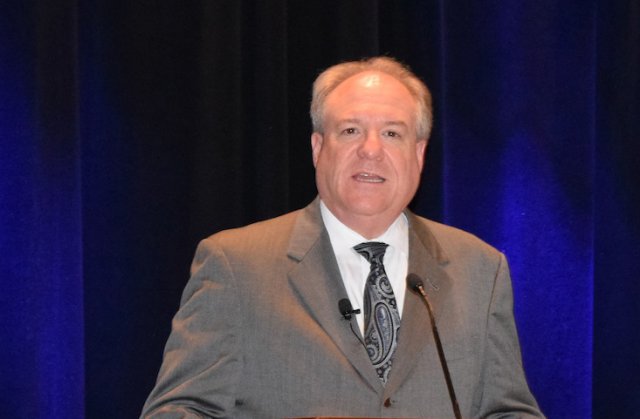 Jim Williams, who managed the FAA office to integrate drones into the U.S. airspace, retired last week. Before departing for a vacation of visiting ballparks with his family, Williams spoke at McKenna Long & Aldrige’s unmanned aircraft systems symposium in Washington, D.C.
Jim Williams, who managed the FAA office to integrate drones into the U.S. airspace, retired last week. Before departing for a vacation of visiting ballparks with his family, Williams spoke at McKenna Long & Aldrige’s unmanned aircraft systems symposium in Washington, D.C.
Now that he is outside the FAA Williams can speak more freely about the path and challenges to drones operating safely in American skies. Here are some points that stood out as he reflected on his time at the FAA, and looked to the future of unmanned flight:
1. He expects drone package delivery in five years
“That’ll be fairly routine, be it in rural areas. It’s going to be real tough to do it in a built-up major metropolitan area outside of Washington, D.C., because how do you deal with the helicopters that are flying sort of randomly,” Williams said. “When they figure that out I think it’ll happen. There’s no other reason, no other barrier to doing that.”
2. Amazon’s drone program is a juggernaut, but seems out of touch with the challenges of flying safely in cities
“They’re pushing the envelope in every realm. They want a fully automated system. They want it to be able to take random routes to deliver wherever they want to deliver. It’s really a big challenge,” Williams said. “If the small rule [for commercial drone flight] is walking then they’re sprinting.”
Williams stressed the challenges of autonomous drones flights in major cities, particularly working around helicopters and small planes.
“I think their understanding of the difficulties is probably on the low end,” Williams said. “But they’re working hard. They’re motivated, they’re well funded.”
3. He thinks we may eventually see unmanned cargo jets
“In 20 years, who knows, large cargo aircraft could be flying and hauling cargo — especially over the oceans — those long, boring flights,” Williams said. “There’s already a couple of the air carrier type cargo haulers that want to look at reducing the crew required during a long-haul cargo flight to one.”
4. He described his former job as enough work for three people.
Williams said he was pleased to have convinced the FAA’s program management agency to take on one aspect of his former duties, managing radio spectrum and allocating it fairly for unmanned commercial flights. Williams described this as a big problem for the agency to solve.
“It really is a full-time job,” Williams said. “I was the only one who was really working that for about three years. And it really is a big barrier for the industry.”
The rest of Williams’s former duties are being divided between two new positions, which will split up internal and external work.
“The job was worthy of three people doing it,” Williams said. “Not that I could do three people’s work.”
5. He would’ve liked to get the proposed rules for commercial drone flight done sooner
When moderator Mark Dombroff asked Williams about his greatest disappointment with respect to drones, he cited the time it took to release the proposed rules for drones weighing under 55 pounds. These missed deadlines were a point of frustration for many in the drone community.
“When I took over I thought we’d get it out in a few months,” Williams said. “But the bottom line was what I inherited wasn’t very good. And so it needed a lot of work. And what you see is I think a much better product than what I inherited when I took over.”
6. Having the White House’s attention isn’t fun
“Everybody who thinks having the White House interested in your program is a great thing, no,” Williams said. “Just a lot of scrutiny from them and everything is questioned about how it is going to fit in the bigger scheme of things. It’s very much a blessing and a curse to have that level of attention.”
After all of the delays, the FAA surprised observers by releasing its proposed drone rules on the Sunday morning of President’s Day weekend. On that same Sunday, the White House issued a presidential directive ordering federal agencies to publicly disclose where they fly drones in the United States and what they do with the data from aerial surveillance.
7. He’s not a big fan of the proposed drone legislation from Sen. Cory Booker (D-N.J.) and John Hoeven (R-N.D.)
“Their heart was in the right place. They really were trying to do what they could to help the FAA,” Williams said. “They missed the mark. The good news is they did come to the FAA and ask what we thought of it. And we told them. So hopefully the bill — if there is one passed — it’ll be different than the one that was proposed.”
Photo: Bill Carey
Source: Washington Post

When I first studied the proposed rules for commercial drone flight my immediate conclusion was that a highly intelligent and “down to earth” person (or team of people) had been involved in the process. Having now read this article I think I know who that person was.
Thank you for sharing this interview on the forum!